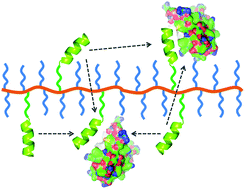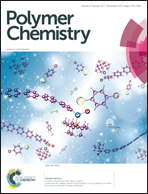Multivalent peptides displayed on OEGMA-based copolymers for the modulation of protein–protein interactions†
Abstract
Direct conjugation of peptides to large polymers has been a promising strategy to overcome the intrinsic limitation of peptides in terms of circulation lifetime, proteolytic stability, and cell/tissue uptake efficiency. As a comb-shaped derivative of polyethylene glycol (PEG), poly(oligoethylene glycol monomethyl ether methacrylate) (pOEGMA) has recently attracted a great deal of interest, which leads to the development of new polymer–protein conjugates. However, pOEGMA has rarely been exploited for the construction of polymer–peptide conjugates. This study reports a new class of copolymer–peptide conjugates which exploits pOEGMA as the polymeric backbone, into which multiple copies of peptides are incorporated. Peptides that can efficiently modulate the protein interaction of p53 and Mdm2/Mdm4 were selected as a model to explore the effect of the composition of OEGMA-based copolymers, the crosslinker length, and especially the number of conjugated peptides on the binding affinity to the target protein. We demonstrated that the binding affinity of the conjugated peptides to the protein is slightly increased (or at least not compromised) even when a large number of peptides (up to 45) are displayed on copolymers because of the positive contribution of multivalent effects. Compared to linear or branched PEGs, OEGMA-based polymers offer superior flexibility in the structure for finely modulating the bioactivity of pOEGMA–peptide conjugates, which is of particular interest for further biomedicine applications. This study not only generates unique multivalent peptide-displayed copolymer conjugates with therapeutic potential, but also provides insight into the design of other therapeutic polymer–peptide conjugates.


 Please wait while we load your content...
Please wait while we load your content...